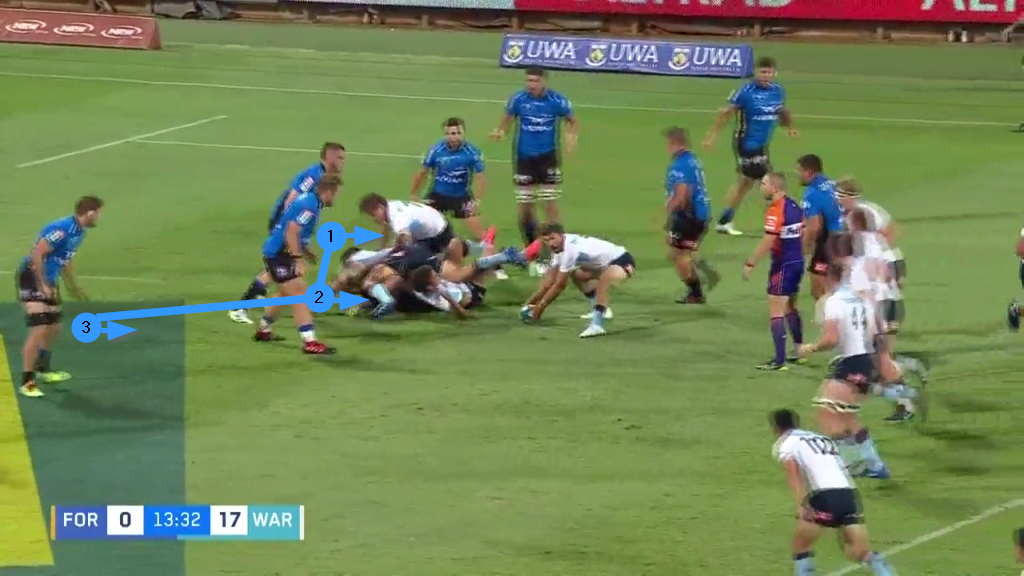It is always nice when circumstances come together to make theory absolutely limpid, and crystal clear in practice. It is even better when they do it in such a way as to tie more than one theme together at the same time.
Over the past few weeks, I have written two articles for The Rugby Site How to make a same-way attack really work and “How to find the right angle at cleanout time” which are very much connected as part of an attacking philosophy.
The first article of the pair examined how to move your attackers around to the far side of a stream of rucks effectively:
“The idea is a simple one: to set rucks quickly and move your own attackers around the outside edge of the breakdown more quickly than the opponent is able to do on defence. The theory goes that, by the time you have reached the far side-line, you will have created an exploitable gap.”
The second article showed how you can create space around the open-side corner by turning the cleanout in towards the middle of the ruck and ‘walling off’ the defender:
“By angling the cleanout at 45 degrees, they [cleanout players] can increase the space between the ruck and the first defender next to it. This can immediately benefit the attacking scrum-half by creating a wider channel for him to exploit.”
The recent Super Rugby Pacific game between the Western Force and the New South Wales Waratahs provided a near-perfect example of how you can mesh the two themes to score a try from a set-piece launch play.
The sequence lasted for five phases and only 22 seconds of game time, with an attacking lineout near the Force 22m line providing the platform for New South Wales. The first two phases combined a dummy lineout drive with the insertion of the blind-side wing (number 14 Mark Nawaqanitawase) on the first ball-carry around the end of the line:
The aim of the dummy drive is to condense as many of the Force forwards in one place as possible. The defender on the right edge of the maul (prop Santiago Medrano) takes the bait and it leaves him slightly late to peel away and participate in the tackle on the Waratahs’ wingman. Here is the situation at the first ruck:

Even though Nawaqanitawase has crossed the advantage-line, three Force forwards have made it around the corner of the first breakdown and are set with time to spare. All three are facing forwards and ready to push upfield once the ball is lifted by NSW scrum-half Jake Gordon. The cleanout at the first ruck is more or less straight ahead, without any significant angle, and the defence is pretty much ‘in shape’.
The third phase of the attack improved the odds of offensive success:
The second New South Wales ball-carrier (prop Angus Bell) engages the first Force back, beyond the three forwards who cantered around the corner of the first ruck. This is where the principles of same-way attack and angled cleanout start to see a dividend paid out:

As Gordon goes to dig the ball out, three more Force forwards have circled around to the far side of the ruck, but they are still moving laterally as the ball is played, and therefore not ‘set’.
The cleanout is carefully angled by number 4 Jed Holloway and number 3 Harry Johnson-Holmes to give the Force defenders on the ‘wrong side’ of the ball further to run, and open a corridor between the ruck and the first defender on the far side. The strain on the D is starting to show.
The pay-off comes on the very next phase of attack:
New South Wales second row Hugh Sinclair carries, and there is another angled cleanout by number 8 Will Harris over the top of him:

The defence reaches breaking-point, with only two Force forwards making it around the corner of the ruck on this occasion. More importantly, hooker Andrew Ready (“1”) makes an mistake, running straight past “2” Harry Lloyd and into second defender, rather than tucking into the space inside him. With Harris walling off all the defence on the other side, a clear path opens up for Michael Hooper to run through and score from the acting half-back spot – the classic signpost of an effective angled cleanout.
Summary
The sequence as a whole illustrates with great clarity how well the principles of same-way attack, and angled cleanout work in combination with each other. The offence does not need to do anything ‘special’ to claim an advantage from this type of scenario. All that is needed is impact at the point of contact, work rate from the forwards around the corner of the ruck, and accurate angles of entry to the tackle at cleanout time. The scoring opportunity will take care of itself.












.jpg)

.jpg)







